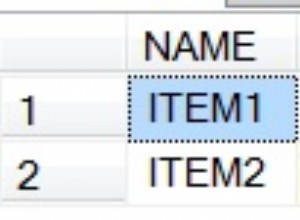आप जो चाहते हैं उसे बाहर निकालने का यह एक कच्चा-एसक्यूएल तरीका है, मुझे लगता है:
select * from articles_users where article_id in (select articles.id from articles inner join articles_users on articles_users.article_id = articles.id where user_id = 1) and user_id = 2;
आप रेल में उपयोगकर्ता आईडी कहां बदल सकते हैं:
ArticlesUser.find_by_sql(["select * from articles_users where article_id in (select articles.id from articles inner join articles_users on articles_users.article_id = articles.id where user_id = ?) and user_id = ?", @user1.id, @user2.id])
या अनेक आईडी के लिए::
ArticlesUser.find_by_sql(["select * from articles_users where article_id in (select articles.id from articles inner join articles_users on articles_users.article_id = articles.id where user_id = ?) and user_id IN (?)", @user1.id, [@user2.id,@user3.id]])
तो नमूना डेटा से (आपके अन्य प्रश्नों से):
mysql> select * from articles_users;
+----+---------+------------+
| id | user_id | article_id |
+----+---------+------------+
| 1 | 1 | 1 |
| 2 | 1 | 2 |
| 3 | 1 | 3 |
| 4 | 2 | 1 |
| 5 | 2 | 2 |
| 6 | 3 | 1 |
| 7 | 3 | 3 |
| 8 | 4 | 4 |
+----+---------+------------+
8 rows in set (0.00 sec)
यह इस प्रकार मान लौटाएगा:
mysql> select * from articles_users where article_id in (select articles.id from articles inner join articles_users on articles_users.article_id = articles.id where user_id = 1) and user_id = 2;
+----+---------+------------+
| id | user_id | article_id |
+----+---------+------------+
| 4 | 2 | 1 |
| 5 | 2 | 2 |
+----+---------+------------+
2 rows in set (0.00 sec)
mysql> select * from articles_users where article_id in (select articles.id from articles inner join articles_users on articles_users.article_id = articles.id where user_id = 1) and user_id = 3;
+----+---------+------------+
| id | user_id | article_id |
+----+---------+------------+
| 6 | 3 | 1 |
| 7 | 3 | 3 |
+----+---------+------------+
2 rows in set (0.00 sec)
या एकाधिक उपयोगकर्ता-आईडी के लिए:
mysql> select * from articles_users where article_id in (select articles.id from articles inner join articles_users on articles_users.article_id = articles.id where user_id = 1) and user_id in (2,3);
+----+---------+------------+
| id | user_id | article_id |
+----+---------+------------+
| 4 | 2 | 1 |
| 5 | 2 | 2 |
| 6 | 3 | 1 |
| 7 | 3 | 3 |
+----+---------+------------+
4 rows in set (0.00 sec)
आपने एक एसक्यूएल रास्ता मांगा है - लेकिन ऐसा करने के लिए लगभग निश्चित रूप से एक रेली तरीका है ... लेकिन यह आपको शुरू करना चाहिए, और आप इसे यहां से नीचे कर सकते हैं।




